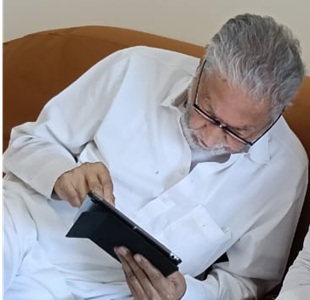By Abdul Rashid Agwan
There is no valid comparison between Yoga and the Islamic prayers as they could be found in different domains. However, the recent hype around Yoga, involving some stray thoughts on the idea that both have certain similarities, can spur anyone to reflect on whether these religious practices do have some similarities or not, and why.
The discussion that follows here is neither a recommendation to consider the two different concepts as compatible with each other or to undermine the gross difference that exists between them but the intention here is to make evident what is the nature of perceived similarities or differences between them so that they could be understood in a better perspective.
Similarities between Namaz and Yoga
1.Both have a religious significance, although some Yoga preachers deny it in spite of its known religious sanctions and try to convince or confuse people that religion can be delinked from Yoga or people of non-Hindu denominations can use their own sacred formulae while performing it.
2.Both involve some sort of physical activity, Asanas in Yoga and Arkan in Namaz. However, Muslims hardly have a thought, while performing it, that Namaz is an exercise in itself. At the best Namaz can be taken as an active prayer where words and actions of a performer come in sync on a focused point, God.
3.Yoga is claimed to increase power of concentration through mediation and Namaz is understood to have the same effect though unconsciously. In Namaz concentration is required on what is being said and acted upon while surrendering oneself before the Almighty God.
4.Both need isolation from the routine and the worldly things, to concentrate on the designated purpose.
5.Both are performed under the guidance of an expert, Guru in Yoga and Imam in Namaz.
6.The root meaning of ‘Yoga’ in Sanskrit and ‘Salat’ in Arabic is the same, i.e. “to connect”.
7.The word ‘Namaskar’ used in Yoga and the word used for Islamic prayers, i.e. ‘Namaz’, have the same meaning, i.e. “to bow down”. In fact, their root word is also the same, Namas. In Malayalam the word used for Namaz is just, Namaskaram!
Dissimilarities between Namaz and Yoga
1.Their objects are different. Namaz is useful for connectivity with God whereas Yoga is recommended for self-realization, i.e. connectivity with the self.
2.It is prohibited in Namaz to think of anything other than God and His bounties and human accountability to Him, it being a human interaction with the divine. In Yoga human mind can be focused on anything like nose, flame of a lamp, a dot on the wall etc and then gradually going deep inside the blank word, to take what is called as Samadhi.
3.Namaz prepares a performer for an outwardly engagement whereas Yoga makes a man more and more inwardly engaged.
4.Ablution, purity of place, sound intention, sober clothing and direction towards Ka‘abah are prerequisites of Namaz whereas there are no such terms for Yoga.
5.There is no limit to the number of Asanas in Yoga and more can be added or subtracted anytime and by anyone without authority. Consider this statement, “There are thousands of asanas. So it doesn’t matter if we drop one (Surya Namaskar). We told them (Muslims) they could take the name of Allah in place of Surya. There is no difference.” This is not the case with Namaz. It is a standard practice throughout the Muslim world with only a few superficial variations due to interpretative understanding and no one as the authority to alter it.
6.Guru is required in Yoga as an outsider to see that it is performed by the performer in the right way but in Namaz the Imam actually leads the prayers and he is part of it.
7.Namaz is a coordinated and focused act to achieve one goal, to seek pleasure of the Almighty God, while implicitly availing physical and social benefits. People may perform Yoga with different motives, generally for material gains such as for good health, weight loss, controlling back pain, etc. Thus, the intended outcomes are different.
8.Namaz is said to be useful to promote chastity and morality in society whereas Yoga rather instigates it due to free mixing of different sexes in Yoga classes and having women as majority of Yoga teachers, like as many as 77% in America.
9.Mosque where Namaz is collectively offered is considered as a community property where as Yoga center is generally a private affair.
10.Imam who leads prayers generally belongs to the lower rungs of society and not necessarily a paid one but Yoga teachers are generally better off. It is because Imam does his duty as a religious and social obligation but a Yoga teacher takes up the work as career. Many of the Yoga preachers in the world have amassed huge financial empires, making it an industry of $ 6 billion. Namaz is not an industry at all.
11.Namaz is a core integer of Islam, whereas Yoga is one of the many doctrines in Hinduism. A Muslim is not allowed to give up Namaz whereas Yoga can be practiced at sweet will and according to motivational level of an aspirant. Thus, Namaz is obligatory on Muslims and can be forced upon them by a government but Yoga cannot be thrust upon them or on any other sections against their unwillingness.
12.There are many complicated Asanas in Yoga that can harm anyone on not doing them well but Namaz has a simple system which can be followed easily, even by children of 5 years of age.
It is evident from the mentioned similarities and differences between Namaz and Yoga, that in spite of apparent similarities in their physical forms they immensely differ in their intent, scope and outcome.
The starkest value of Namaz is that it prepares a man for one’s complete surrender to the divine order, leading to the development of piety and accountability in society. As such Namaz is a manifest instance of monotheism. It teaches that nothing can be taken as deity other than God. Surya is considered by many Hindus as a deity but it is not God unto itself, even according to their own standards. Now, in the age of science even the claim of solar divinity stands unacceptable.
In this regard many teachings in Hinduism are quite similar to what Islam inculcates.
For example Gayatri Mantra can be referred, which has been translated as: “Oh God, the Protector, the basis of all life, Who is self-existent, Who is free from all pains and Whose contact frees the soul from all troubles, Who pervades the Universe and sustains all, the Creator and Energizer of the whole Universe, the Giver of happiness, Who is worthy of acceptance, the most excellent, Who is Pure and the Purifier of all, let us embrace that very God, so that He may direct our mental faculties in the right direction.”
Unfortunately, many Yoga preachers have taken Gayatri Mantra as a means for “awakening the Sun” and it is used in the context of ovation to Surya rather than as a remembrance and supplication to the Almighty God for which it has been originally composed.
The advocates of Surya Namaskar, who take it as an integral part of Yogasana, even refer to a verse of Rigveda in support of Surya Namaskar and as a Vedic proof of veracity of Yoga itself; however, out of the context, like their treatment with the essence of Gayatri Mantra.
It is understood that the first reference to Yoga and Surya Namaskar has been made in the hymn 5.81.1. of Rigveda. The well known nationalist philosopher, Sri Aurobindo Ghosh, interpreted the said verse like this, “The illumined yoke their mind and they yoke their thoughts to the illuminating godhead, to the vast, to the luminous in consciousness; the one knower of all manifestation of knowledge, he alone orders the things of the sacrifice. Great is the praise of Savitri, the creating godhead.”
It is evident here that the Sun cannot be considered as the “knower of all manifestations of knowledge” being a non-living thing, in spite of its utility as a source of energy for man. Therefore, the understanding of the word “Savitu” in the hymn should only lead to the one Who illuminates the entire world with billions of stars in billions of galaxies, including the small star (Surya) of our own solar system. The wrong inference of the verse points to the utter confusion of the bogey of Surya Namaskar in gripping with the real object of mediation in Yoga as taught by the hymn, i.e. to focus on the Light of lights.
It is really strange that many proponents of Surya Namaskar are not prepared to understand the position of Islam on it, which is also valid from the above-mentioned interpretations of Gayatri mantra and the pertaining hymn of Rigveda. The typical instance of Swami Agnivesh could be made here.
The international president of Arya Samaj argues in his 12 June message on the official website of the community, “May I respectfully ask my Muslim brothers and sisters why they should do Kaaba Namaskar (saying Namaz facing Kabaa in Saudi Arab) which is no less an idol as compared to the Sun, the inexhaustible provider of energy?”
It is a well known fact that Muslims does not worship Ka‘abah. Had it been a fact, a symbol of Ka‘abah would have been made compulsory to put before the praying person. Ka‘abah simply symbolizes a direction, towards which prayers are to be offered to the Almighty God. Namaz is offered even inside the four walls of Ka‘abah itself. Perhaps, the leader of Arya Samaj is not contemplating on these facts and attempts to convince Muslims to adopt “Surya Namaskar” whom he wrongly suppose as offering “Kaaba Namaskar”. As a vanguard of sanctity of Vedas and a presumed believer of monotheism, one can expect a community leader like him to appreciate Muslims’ stand on the issue of Yoga rather than advising them to accept it in its present form.
A well known German philosopher have rightly said, “The discovery of truth is prevented more effectively, not by the false appearance of things present and which mislead into error, not directly by weakness of the reasoning powers, but by preconceived notions, opinion, and by prejudice.”
In any case, the forthcoming Eid-ul-Fitr will once again show to the world that Namaz is performed, distantly similar to Yoga but for a distinct purpose. Namaz can be taken either as a purified and standardized Yoga or as an immense addition to its object, scope and outcome and not just as a physical exercise. Those who want to deem both at par can take Namaz at best, as Yoga Plus.
One can wonder here, will the Prime Minister Shri Narendra Modi watch and reflect on Eid Prayers as the key proponent of Yoga in the present time and compare their form and impact on human life, as his maestro K.S. Sudarshan, the erstwhile Sarsanghachalak of RSS, has done in Mysore and tried to repeat it in Bhopal, a few days before his death? If he does so, then it may lead to a better understanding on Yoga in the contemporary world and in the development of badly needed communal harmony in the country.
He expected Muslims to join him on the Rajpath on 21st June and many of them have even done so, in spite of Ramadan and fasting. Now, it is his turn to payback the goodwill.
—-
[Contributor is an analyst, social activist and author of many books including his recent one, Islam in 21st Century: The Dynamics of Change and Future-making]







0 Comments